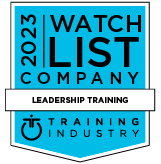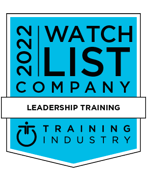Mastering Leadership Team Development: Strategies for Unleashing Human Potential

Contents
Leadership teams can’t just show up each day, knuckle down, cross their fingers, and hope for the best. Building effective leadership teams does not happen by chance or default; it requires intentional development and continuous improvement. It requires thoughtful leadership development strategies.
When you say, ‘leadership team development’, many CEOs think of technical abilities. The IQ of their team. Aspects of leadership like strategic planning, business acumen and decision-making. But in today’s fast-paced corporate landscape, the technology revolution means change is constant and complex. Your real focus in developing leaders, especially the most senior leadership team, should be on the key differentiator, human skills.
We’re killing the words ‘soft skills’, as there is nothing soft about leading people. Just ask Jocko Willink, former Navy Seal, and author of extreme ownership. As Culture is a mirror of leadership, you want a strong high-performing culture, you need a strong high-performing leadership team.
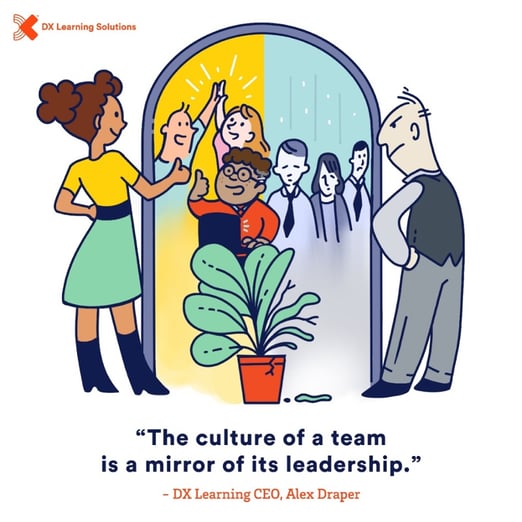
As Culture is a mirror of leadership, you want a strong high-performing culture, you need a strong high-performing leadership team.
High-performing leadership teams intentionally build environments for their teams to thrive. It's a two-way street. High-performing leadership teams need high-performing cultures, where employees from top to bottom speak up early and often about what is working, so leaders do more of it, and what is not working, so they do less of that.
This data stops the "Yoshida Iceberg of Ignorance" concept from happening and reduces performance challenges. The iceberg of ignorance is a concept from organizational learning theory, specifically from the book "The Team Handbook," by Peter Scholtes. In the book there is a model that illustrates how information about problems tends to get filtered and reduced as it moves up the organizatoinal hierarchy.
In the model, frontline workers are seen as having the most awareness of problems (the base of the iceberg), but as information moves up to managers and executives, it becomes increasingly filtered and distorted, resulting in those higher up having less awareness of the actual issues (the tip of the iceberg).
You can find more information about the Yoshida Iceberg of Ignorance in "The Team Handbook" by Peter Scholtes.
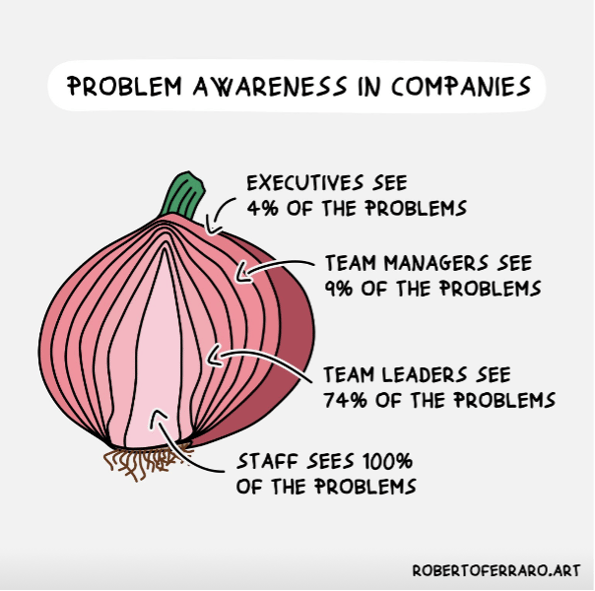
(Illustration by Roberto Ferraro)
This is why creating a culture of psychological safety is so important. And it starts at the top.
One of the biggest obstacles to building effective leadership teams? So many leaders just assume that teams are already aligned and know how to work together effectively. It’s tough love when we say: that’s just not true. For people to feel safe, their brains need to be at cognitive ease. How can a brain be at ease when it doesn’t have clarity? Ambiguity drives fear, and fear drives people to stay silent and not speak up, withholding important information from those who need to it so they can make better decisions.
The article will delve into proven strategies and insights for building effective leadership teams, to foster growth and success. It will explore how effective leadership team development can unleash the full potential of every individual and group, to drive performance and sustainable results across the whole organization. Imagine that!
The Importance of Leadership Team Development
"A leader must inspire, or their team will expire." Orin Woodward
84% of employees value psychological safety more than anything, but only 26% of leaders create this for teams (McKinsey).
Everyone leads. We all lead from the seat we are in. Leading is positively influencing those you serve. And we all serve somebody. But none of us were just born to lead. There are no ‘chosen ones.’ We all need to be trained on how to lead; how to combat our brain’s primary protocols. Our brains don’t just need to know how to keep us alive, but how to help other humans thrive too. This is what’s so often missing from leadership team dynamics. They’ve got the IQ, but not the EQ.
Leadership team development is not just for executive teams. Every leadership team, whether leading a small team or an entire department, needs the people skills and tools to inspire, motivate, and guide people towards psychological safety and higher performance. They’re the ones who set the tone for a teams’ culture and how it reacts to inevitable challenges. And they influence 70% of a team’s engagement (Gallup).
We need a common language and framework for building effective leadership teams, enhancing team performance and building a psychologically safe environment for people to speak up early and often. That language is CARE: Clarity, Autonomy, Relationships, and Equity.
Enhancing team performance requires leaders to really embody these principles. To give CARE so their teams CARE back with information to make better decisions. And team members need to ask for what they are not getting. They should feel empowered and safe to ask for what they need to thrive, whether it's support, guidance, or resources. In this environment of mutual respect and support, that’s where the magic happens.
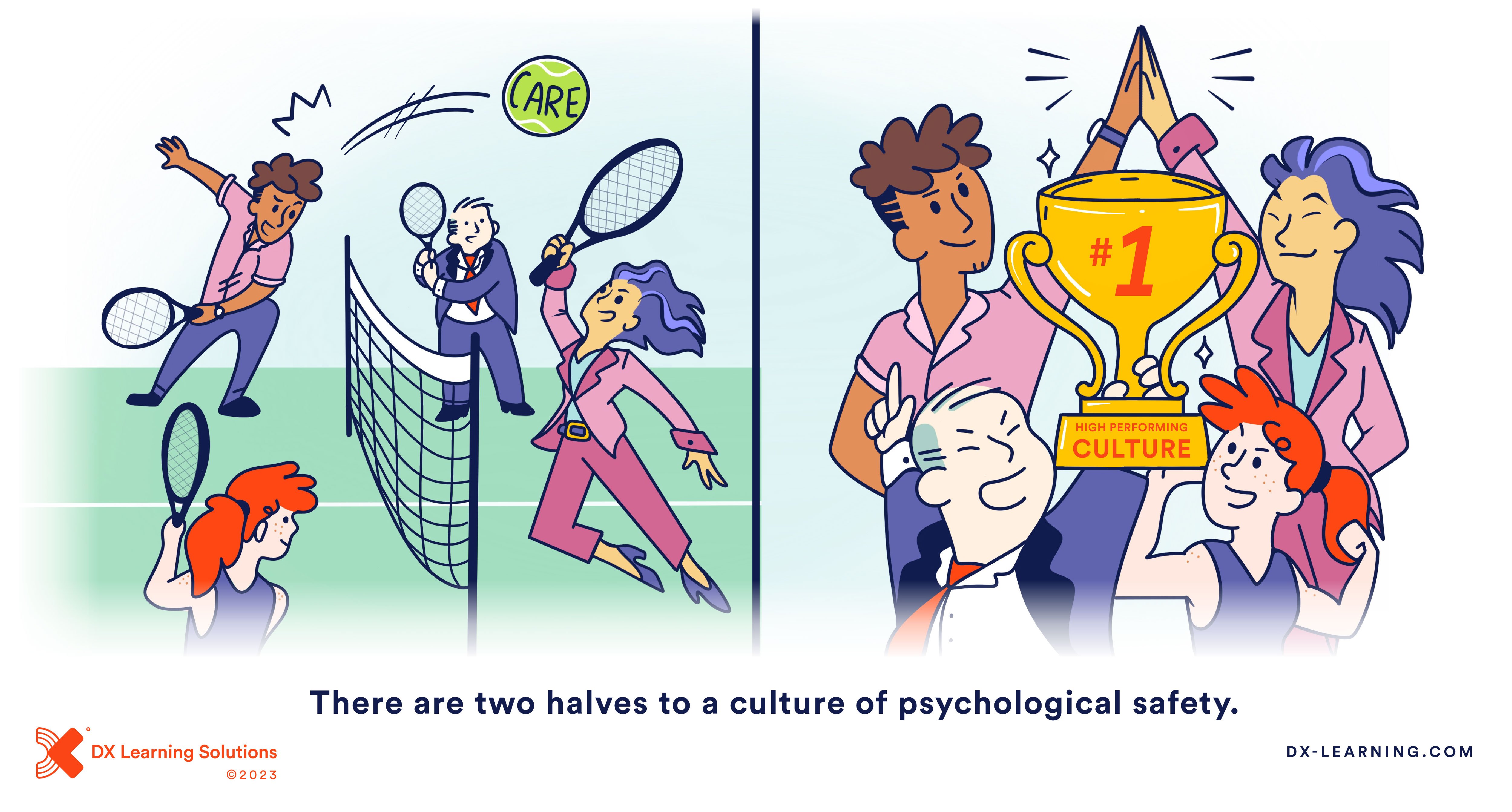
Key Elements of Effective Leadership Teams
An effective leadership team is one where all leaders continuously work on their growth and development and get intentional on ensuring they align on how they lead so their teams get a consistent experience. The more consistent, the stronger the culture. The stronger the culture, the better they will perform.
The foundational elements of building effective leadership teams? At the heart of it all lies CARE. Clarity, Autonomy, Relationships, and Equity® – the four human skills of higher performance.
Clarity – An important aspect of leadership team development is reflecting regularly and engaging in creating an open and constructive feedback loop, with two-way dialogue with teams about successes and setbacks. It’s about providing clear direction and purpose, aligning individual goals to team efforts and a larger vision, sharing information regularly and concisely, and encouraging and supporting others with regular informal feedback and recognition.
When employees strongly agree that the leadership of their organization communicates effectively with the rest of the organization, they are 73% less likely to feel burnt out at work (Gallup).
Autonomy – When leaders demonstrate trust and support, they inspire independence, empowering team members to navigate their own paths and stay accountable for their growth, while staying aligned with the team's overarching goals. It gives every employee their own set of keys to unlock their full potential.
People who use their strengths every day are: 6x more likely to be engaged at work, 7.8% more productive, and 3x as likely to report having an excellent quality of life (Gallup).
Relationships – Strong leadership team dynamics foster trust, collaboration, and camaraderie. People-first leadership is about helping humans to thrive and creating sustainable impact. And having fun while you do it. Leaders trained by The CARE Experienceâ always respect, understand, and uplift the diverse voices in their workforces.
When employees strongly agree that they trust the leadership of their organization, they are 4x as likely to be engaged (Gallup).
Equity – Equity creates an adaptable playing field where each team member has a seat at the table and diverse voices are celebrated and respected. It enriches the team's collective wisdom and decision-making process. By making deliberate steps to break down biases and foster a culture of psychological safety, managers create spaces where team members feel empowered to voice their thoughts and concerns. It creates an environment of innovation and continuous improvement, enhancing team performance at all levels.
Employees who strongly agree that leaders help them see how changes made today will affect their organization in the future are 7.5x as likely to feel connected to their company culture (Gallup).
The CARE Experienceâ brings awareness to what was previously subconscious or undiscussable – it brings everyone face to face with the elephants in the room. This requires openness and a genuine willingness to question our own behavior and actions. It might sound uncomfortable – it is! – but all the good stuff happens outside of comfort zones when you’re building effective leadership teams.
DX Learning’s CARE playbook and tailored leadership team development programs cultivates greater connectedness, better relationships, and trust, leading to greater effectiveness. Managers understand how to regularly reflect on their approach, identify areas for improvement, and provide a safe space for employees to engage in a two-way dialogue about what works and what holds people back.
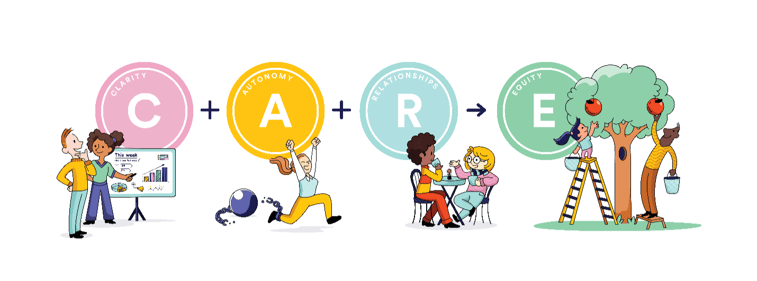
Strategies for Developing High-Performing Leadership Teams
Here are some actionable leadership development strategies to train everyone in CARE for a common language:
Tailored Leadership Development Programs
Leadership journeys will – and should – look different for every person. What do they need now, and down the road? If you put everyone on the same path, you’re just going to end up with people struggling at different hurdles, burnt out along the way, and with metaphorical sprained ankles.
Speak to managers as humans. Conduct 360-degree feedback evaluations to gain insight into each human’s capabilities and areas for growth. Then you can fill those leadership gaps with a leadership team development program like CARE, that caters to diverse learning styles and preferences.
DX’s leadership development programs recognize that each individual within the team possesses unique strengths, weaknesses, and needs, and that every organization has unique requirements and challenges. Inclusive leadership development strategies that can be tailored, like our very own EDX Leadership Simulations, allow each leader to leave with the self-awareness that creates real and immediate impact change in your people, teams, and organization. A study by Gallup found that disengaged employees cost U.S. companies up to $550 billion a year in lost productivity. Executives who create a negative work environment due to lack of self-awareness can contribute to that employee disengagement.
It’s hands-on, scientifically proven, experiential, and immersive training, and it works. Leaders trained by The CARE Experienceâ are self-aware; they understand their emotions, strengths, and weaknesses, and embrace vulnerability while regulating their reactions. They forge stronger bonds with and create engaged, high-performing teams where everyone is living the company culture. A leadership team that has a unified experience and knowledge of each other’s strengths and weaknesses will perform better than one that does not.
It’s a radical shift, but once it’s firmly ingrained in managers, it all takes off, and it trickles down to teams. Everyone starts to really care.
Fostering a Culture of Continuous Learning
High-performing leadership teams flourish in an environment where learning is not just encouraged but woven into the organizational ethos and everyday operations.
Leading by example is key. When leadership team dynamics demonstrate a commitment to managers’ own ongoing development, openly sharing their learning journeys with others, it sets a precedent for the whole team. It signals that learning is a lifelong priority worth pursuing, not dreaded homework or a one-off workshop.
You end up with a culture where people eagerly seek out new knowledge to sharpen their skills and inspire each other. They jump at chances to challenge themselves. Every interaction becomes a chance to learn, whether it’s through informal feedback or collaborative projects.
DX Learning’s leadership development strategies cement this curious mindset. Embracing continuous learning as a core value cultivates a sense of camaraderie, curiosity, and communication. People exchange insights, share challenges, and support each other. It gives you teams that can adapt, innovate, and excel in a changing landscape. It spotlights your future high potential leaders!
Measuring the Impact of Leadership Team Development
You can’t manage or improve upon what you don’t measure! You waste time, effort and resources, Plus, it’s demoralizing and confusing for leaders to make efforts but not be able to see the impact. That’s the crucial bit that keeps them invested and inspired.
Too often, measuring is an afterthought. If you don’t build in key metrics from the start, it’s hard to connect past dots. Measurement needs to be one of the first elements of building effective leadership teams that’s set in stone.
Although 85% of HR teams believe that measuring the impact of executive team development programs is important, 48% aren’t satisfied with how they are measured (Heidrick & Struggles). Even among companies that say they do measure impact, it’s often only basic participant reactions to training that are recorded. Checking the attendance box isn’t enough. Showing up doesn’t guarantee that leaders are truly developing their skills to become better leadership teams.
But most organizations struggle with pinpointing the metrics that show how leadership team development correlates to specific business outcomes. You need to measure reaction, learning, behavior change, and results. That requires honest, transparent, and data-driven conversations.
Key Performance Indicators (KPIs) set for each manager act as a magnifying glass. They help zoom in on specific areas of improvement. When setting KPIs, leaders have to get brutally honest and self-aware: why weren’t these goals reached in the past? It encourages managers to take ownership of their journey, and clearly breaks down their progress. It also gives organizations a better idea of how to celebrate and support leadership teams throughout their individual and collective journeys.
Regular feedback mechanisms, like surveys or one-on-one check-ins, give invaluable insights. Are they feeling more confident? Are they seeing positive changes in their day-to-day work? How are their teams responding to their behavior? That's the kind of intel that helps you fine-tune executive team development strategies and keep the momentum going.
Tools and Resources for Leadership Team Development
People are the most valuable asset any company has. Investing in humans is investing in business growth!
When executive team development is meaningful and scientifically grounded, it can be the difference between visionary managers who carefully take your people and organization to new heights, and ones who act like bulls in china shops and consequently feel like failures. Both attitudes will cascade through the whole organization. That is why leadership development strategies matter.
Ready to see same-day results? Pre-order CAREtoWin: The Four Leadership Habits of High-Performing Teams, the book and explore the playbook for yourself with insights and strategies that will aid in the leadership team development process. That shift in mindset starts today!

FAQs
What makes an effective leadership team?
An effective leadership team is one that embraces the human skills, to embody CARE – aligning and establishing clarity, inspiring autonomy, nurturing relationships, and ensuring equity across their teams.
How often should leadership team development programs be conducted?
It should never be a one-off workshop. Building effective leadership teams requires regular training, ongoing feedback loops, and constant measurement and support. It’s the only way to ensure managers keep growing every day and keep sowing new seeds for others to grow too. Culture is a living, breathing organism that needs to be continually developed.
What are the best practices for maintaining high performance in leadership teams?
Fostering a culture of continuous learning, open communication, and mutual support. Not forgetting regular feedback mechanisms and transparent KPIs to track every person’s progress and nip any emerging issues in the bud.
Insights

Subscribe to Our Monthly Newsletter!
For managers and talent professionals who truly believe in putting people first, the CARE to Win blog is your gateway to the latest insights on human-centric leadership. Join us as we champion the people first movement.
Need some time apart? Are we emailing you too often? Just give us your feedback, and we promise we’ll respond. We really do care. And if it’s still too much, just unsubscribe. It’s cool.
.jpg) Alex Draper
Alex Draper

